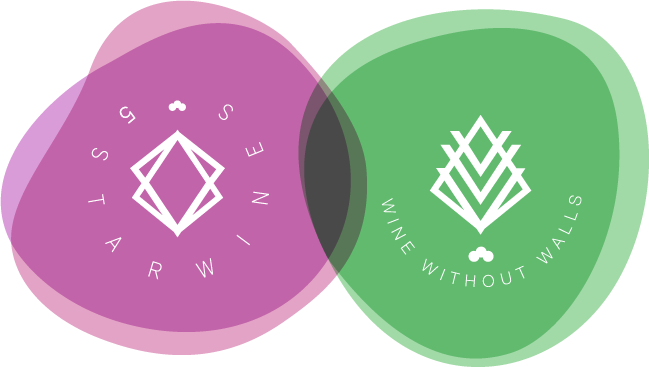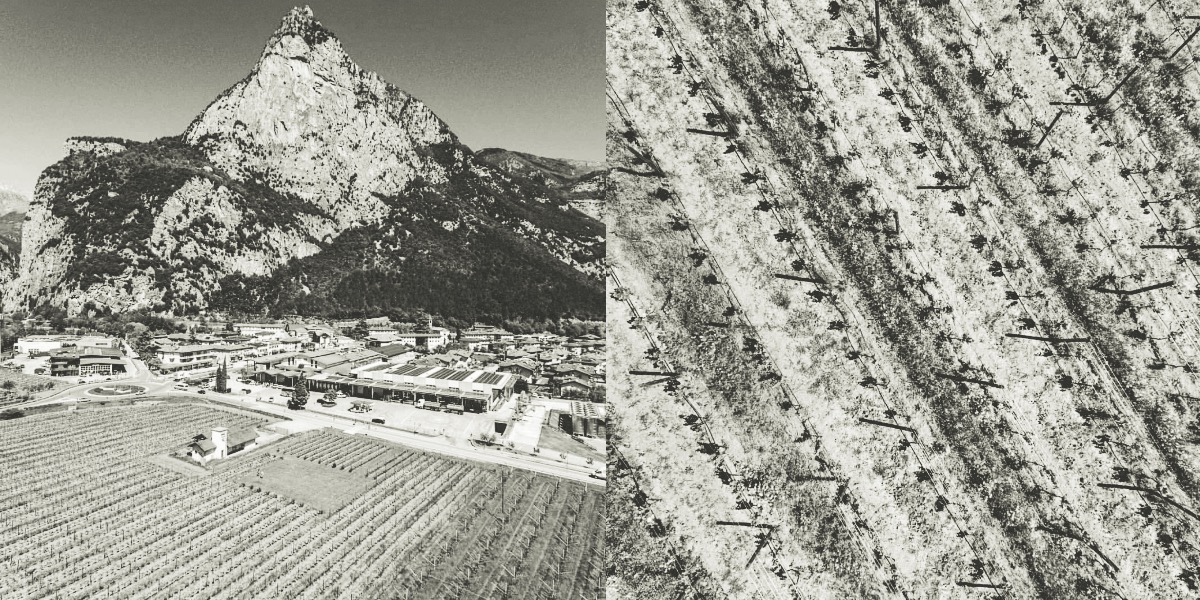
by Margherita Andrenacci | Jan 10, 2020 | Blog Post
Cantina Toblino, represented by its brand manager Giovanni Luigi Brumat, featured in 5StarWines – the Book, with five of its amazing wines represented. Two of which fit the requirements of Wine Without Walls, the selection dedicated to organic wines.
During the last edition of wine2wine, held in Verona in November 2019, Brumat spoke to us about Cantina Toblino and its best seller wines.
The cooperative was established in 1960 by a small group of wine growers that were primarily focusing on two grapes varieties: Nosiola for the whites and Schiava for the reds. The company has grown and developed – now counting more than 600 growers and 800 hectares of vines. Yet that is not all! Cantina Toblino has a special feature: 40 hectares of privately owned and certified organic vines in front of its main building, standing as a symbol of their innovative vision of organic production – that started in 2012. Almost 1/3 of the whole their territory, (300 hectares) are certified organic, therefore Cantina Toblino owns 10% of the total organic vineyards planted in Trento.
What about Cantina Toblino Wines?
There are many bottles from which you can choose; starting from Nosiola, a native grape variety that can be adapted to produce various styles of wine, from a fresh and easy-to-drink wine that undergoes only steel ageing to Nosiola that stands out for its 6 year maturation in large oak barrels, giving complex yet suble oak to this exceptional wine. They even produce a classical late harvest Nosiola which is dry and undergoes 1 year in acacia tonneaux.
And what about Vino Santo?
Cantina Toblino’s Vino Santo was awarded “Best Sweet Wine in Italy” by Gambero Rosso, 2019. But let’s begin from its origins in the early 20th Century. Cantina Toblino started making its first vino Santo in 1965, taking it to the market 7 years later in 1972. Thankfully for Vino Santo, in recent years the production technology has developed thus increasing its quality, longevity and reputation. Now grapes are harvested in the first half of October, then dried for 6 entire months. We are talking about a natural air drying, with the job done by the winds from both Garda Lake and the Dolomites. The Lora wind, from lake Garda builds speed when crossing the Bolzano and Trento valleys. However it arrives as a warm and soft breeze as it crosses the Valle dei Laghi. The other wind, Peler, comes from the Dolomites and is stronger and cool. These winds are crucial for the process, helping to dry the easily water-logged clay based soils.
It is always fascinating being able to hear the history of different wineries, how they were born, their development and their present, the way they are facing changes and the ways their techniques and technology has developed. At 5StarWines and Wines Without Walls we explore these aspects as much as possible, believing that the product is only the final result of a whole history made of family, friendship, hard work and passion, a lot of it.
Pics by: Cantina Toblino
Want to read more articles just like this one?
Get our tips sent straight to your inbox: subscribe to 5StarWines’ newsletter!
[yikes-mailchimp form=”2″]

by Margherita Andrenacci | Dec 19, 2019 | Blog Post
Cantina di Soave’s Lessini Durello DOC Spumante Brut “Settecento33” was awarded “Best Sparkling Wine of 2019” by 5StarWines – the Book, with a phenomenal score of 93/100.
Since that was not the only bottle by Cantina di Soave that made it in our guide, in this blog post we would like to dig deeper into the rich history of an iconic cantina in Veneto. In addition to identifying high-level products, one of our main priorities at 5StarWines is to create connections between wineries and various industry professionals. In this blog we are proud to introduce iconic wine producers, wineries’ directors, and influential figures that play a key role in the wine world.
Wolfgang Raifer, born in the Appiano County, Alto-Adige, is the vice director of Cantina di Soave. In an interview with Italian Wine Podcast host Monty Waldin, Raifer to discusses both the origin of the Cantina and the changes occurring inside the wine world. Cantina di Soave is the biggest producer of Soave wine, with a total of 6000 hectares and more than 2500 growers.
“Soave” is an ancient denomination dating back to the Roman Empire, where the term was used to categorize a wine of great quality. The history of the denomination has always been positive – even though lately there have been some challenges in the market. Raifer claims that the approach to the market, for every kind of product, needs to be gradual and finalized to educate consumers about a specific product: “A brand can’t be strong internationally if it’s not strong also at home”.
Raifer also discusses the high quality and versatility of Soave wines, that makes them both easy-to-drink in the short term and with the complexity of premium wines. The main characteristics of Soave are its typical flavors of citrus fruit combined with a touch of almond flavor and fresh acidity in the palate, never too intense.
Cantina di Soave is also keen on sustainability, as Raifer states in the podcast interview: “We focus on sustainability by enforcing it in the vineyard and in the cellar. Our investment means spending less energy to do what we need to do in the cellars and using only the treatments that are actually needed in the vineyards”. According to Raifer, quality and sustainability are crucial, yet there is the need of being realistic and introducing changes at the right pace. The approach towards organic production needs to be implemented gradually, since 6000 hectares of vines means that there are both professional growers that work on the vineyard full time and smaller growers that can only focus on the vineyards during the weekends.
Environmental sustainability is tightly connected with respect towards growers, culture, and society. A lot have been discussed about sustainability during the last wine2wine event, being it its main focus. Changes therefore must account for all of these factors. Witnessing the work that wineries do taking into account all the steps in the production chain is an incentive for the whole industry, especially when results are tangible. Commitment towards hard work always pays back, and Cantina di Soave is a perfect example of this.
To find out all of the other wines that made it into 5StarWines – the Book, go here!

by Margherita Andrenacci | Nov 20, 2019 | Blog Post
Sustainability and sustainable wine production. It might seem like a straightforward concept, but what does it actually mean? It is something becoming more and more relevant, especially throughout the food and beverage industry. It is a keyword, influencing both the wine market and its consumers; a concept that is growing in value day by day.
The “sustainability” theme officially appeared for the first time in 1972, during the very first UN conference on the Human Environment (also known as the Stockholm Conference). However, it was not until 1987, that the United Nations World Commission on Environment and Development published a report that not only aimed at clarifying the concept itself, but the report was also aimed at instituting a common goal – one that can still be defined as contemporary: “sustainability is the need to grow and develop in a way that can satisfy the current generation without withholding the same possibility for future generations.” (WCED, Brundtland Commission, Our Common Future, 1987).
Today, it is in fact undeniable that terms such “Sustainable”, “Environmentally-friendly” or “organic” can awaken an important awareness in the eyes of the consumer. However, it is a mistake to use these terms as synonyms (B. Campbell, H. Khachatryan, B. K. Behe, J. H. Dennis, 2015, Consumer Perceptions of Eco-friendly and Sustainable Terms). The word “sustainability” is often erroneously used to describe products that are environmentally friendly, completely overlooking its different facets, such as the social, cultural and economic sphere.
With respect to this particular point, researchers Schäufele and Hamm (2017) underline how employing sustainable characteristics in wine production could be a winning strategy, one that would make all the difference, if appropriately paired with the gradual education of consumers. It could also be convenient economically speaking and here’s why: new vine varieties, obtained by interspecific crossings, do not require specific pesticide treatments because they are proven to be more resistant to epidemics and fungi, therefore, this allows for a significant cut-back on production costs and the usage of chemical agents.
However, these new generation vines are still in need of proper regulation since it is crucial to protect the existing species from risk. Such risks include the reduction in biodiversity, the risk of there being an outbreak of new diseases or the risk of customer backlash, having been exposed to changes too quickly to adjust. It is also essential to refrain from underestimating the impact that all of this could have on the wine market, because all of the new varieties would have to compete with the traditional, more traditional options – but this would in turn and would unintentionally highlight the sometimes-extreme use of pesticides in the traditional vines.
Therefore, implementing further changes within the industry requires a certain amount of flexibility on behalf of producers, who may be focusing more on the risks involved rather than the opportunities. It is however impossible to deny how fast the food and beverage world is shifting toward a more sustainable reality; society is now starting to upgrade its standards, shifting its evaluation methods, focusing more in terms of “quality”.
With regards to ecology and environmental sustainability, it is likely that over time, treatment processes will change, reducing the usage of additives and coadjutants, lowering intensive energy oenological practices. A special focus will also be needed for product packaging: bottles are in fact one of the major carbon emission causing factors in the whole wine production process.
To make sure that this road is taken in a uniform and sustainable way, it is important to begin a process of acceptance, a notion that must primarily come from producers and experts in this area. Their responsibility will entail the broadcasting of these changes to the public in a positive and gradual way, through inclusive new generational tools such as virtual reality and the digital world.
5StarWines is aware of the struggles that might arise during the production processes of sustainable wine. This is one of the reasons behind its creation of “Wine Without Walls”, part of 5StarWines – The Book, a section dedicated to the promotion of producers who have devoted themselves to creating biodynamic, organic and reduced sulfite content wine on an international scale.
Sustainability is the main topic for the 2019 edition of wine2wine, being held on November 25th and 26th in Verona, Italy. This is an international forum that is now in its 6th edition. It will host an impressive number of speakers such as Bruce Sanderson, senior editor for Wine Spectator; Sonal Holland MW, India’s only Master of Wine and Gaia Gaja, of Gaja Estates, co-owner and International Brand Ambassador – these are just to name a few. They, among many others, will be discussing the topic of sustainability in all of its forms. Participants will be given the opportunity to network and become involved in practical labs, as well as take part in other activities, all aimed at shaping the future of the wine sector into a sustainable one.
So, will we see you there?
Want to read more articles just like this one?
Get our tips sent straight to your inbox: subscribe to 5StarWines’ newsletter!
[yikes-mailchimp form=”2″]
References
Campbell, Ben & Khachatryan, Hayk & Behe, Bridget & Dennis, Jennifer & Hall, Charles. (2015). Consumer Perceptions of Eco-friendly and Sustainable Terms. Agricultural and Resource Economics Review. 44. 21-34.
Schäufele, U. Hamm, Journal of Cleaner ProductionVolume 147, 20 March 2017, Pages 379-394 Consumers’ perceptions, preferences and willingness-to-pay for wine with sustainability characteristics: A review
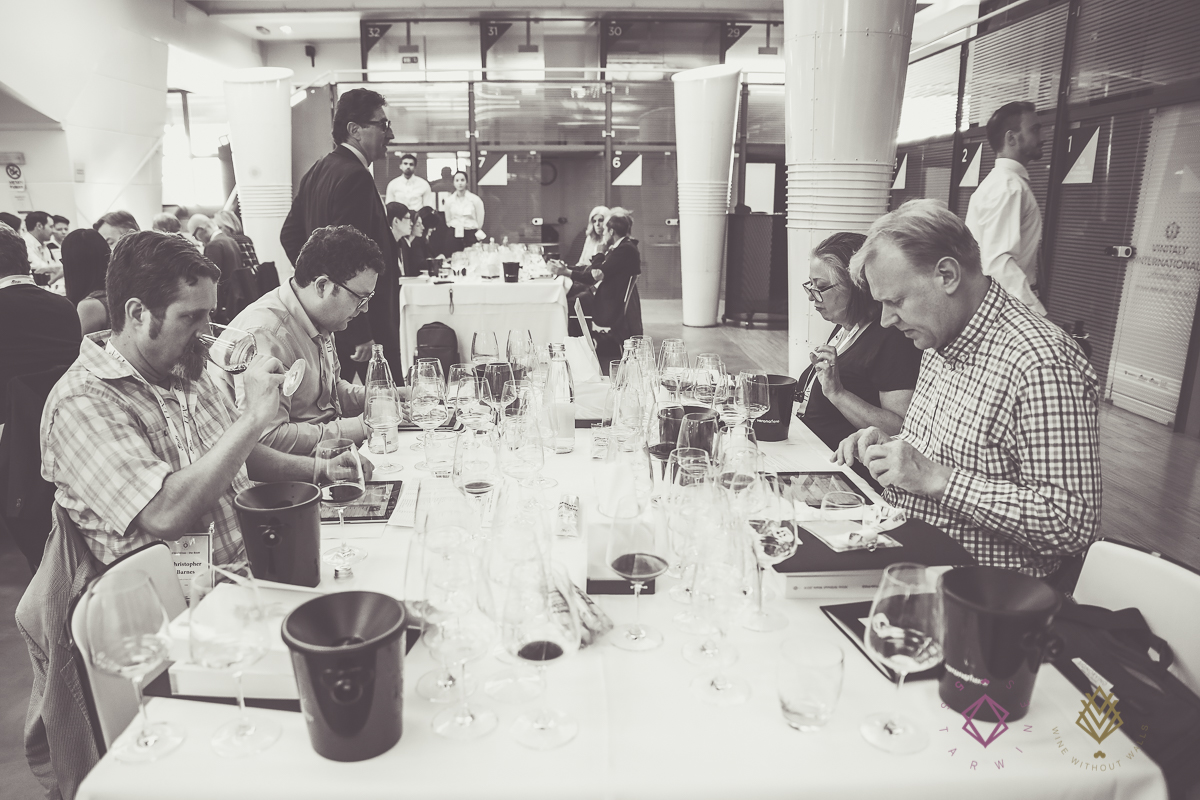
by Marina Lovato | Sep 26, 2019 | Blog Post
April 3rd, 2019: it’s a warm spring morning at the Veronafiere. At Vinitaly International, 5StarWines is ready to kick off: the selection of Italian and foreign wines, made by highly qualified international experts will be held here for the next three days. The main protagonists will be the bottles themselves, or at least an abstract image, imagined by the judges as they savor the contents on their palate. In charge of identifying the grape varieties, origins and quality of hundreds of the wines are the judges who blind-taste and scrutinize each sip during the ongoing process.
This time round, we would like to take a look behind the scenes of 5StarWines and shift our attention to the human factor of the event: who are the typical judges of 5StarWines? Which criteria are used to select them? How do they prepare for a demanding tasting that involves the sampling of hundreds of different wines? On our blog we have attempted to answer these questions: starting from the analysis of the people selected, we will try to understand the different qualifications required of these professional tasters.
Judges and the Scientific Committee
First of all, let’s define the whole jury structure, that is, the professionals that gather every year in Verona to evaluate the bottles that are eventually published in 5StarWines – the Book.
At the top, there is the Scientific Committee consisting of five General Chairmen, presided over by the Senior General Chairman. The main tasks required of the Scientific Committee include the selection of the jury, as well as the final judgement of the wines evaluated, having been submitted to them by the various tasting panels; this is done by awarding each bottle with a score equal to, or greater than, 85 points. In the 2019 edition, the title of Senior General Chairman was entrusted to Lynn Sheriff MW, a renowned South African wine expert and educator.
The jury is divided into Panels composed of five judges and, coordinated in turn, by a Panel Chairman or President of the jury. The panel consists of a diverse group of individuals that come from all over the world, with different backgrounds and that work in various fields within the wine industry: each group tastes a fixed number of bottles per session. A specific panel is entrusted with the evaluation of organic, biodynamic and low sulfite wines that make up the special section called Wine Without Walls. In addition to the qualified professionals, the jury also includes Associate judges, as well as wine producers who are members of Assoenologi.
At the end of the three days’ tasting, only labels with a score of 90 points or more will be published in the guide. Last April’s event saw the participation of 100 judges and the promotion of 676 wines.
A world of wine experts
Besides the aforementioned wine producers, there are journalists, columnists, authors, buyers, importers, oenologists, consultants and influencers that also attend 5Star wines. Their presence provides a key link to the final consumer: their ability to taste and evaluate wine is based on their experience as connoisseurs of trends, customer behaviors and international markets.
Then there are of course the professional tasters. Those members of the jury that deal with every aspect of the wine can be further subdivided according to their title (often expressed through an acronym) and the level of certification achieved. Let’s talk about these qualifications in detail.
Who are the typical judges?
Master of Wine (MW): The Institute of Masters of Wine was founded in 1955 and is based in London. The world over, there are only 390 individuals that hold this title. The low number is demonstrative of the extremely thorough training and breadth of knowledge required to become an MW. The courses are held on three continents (Europe, Australasia and America) and require at least three years to complete. The exam, which can be undergone five times within six years, includes three blind-tasting sessions of 12 wines each; five theoretical topics to be developed on various matters such as production, wine business and trending topics; and a research paper of 10,000 words.
Master Sommelier (MS): This certification focuses on the role of the sommelier in hospitality and catering. There are four mandatory levels one must pass to become an MS: Introductory, Certified, Advanced and MS Diploma. There are approximately 240 MS in the world, they hold the highest degree of skill in recognizing wine and its qualities as well as how they interact with food.
Italian Wine Ambassador (IWA) and Italian Wine Expert (IWE): IWA and IWE qualifications are issued by Vinitaly International Academy (VIA), an institution that deals with the education, biodiversity and authenticity of Italian wine. The requirements to access the course are a proficiency in English, and ideally, previous certification through the WSET diploma or its equivalent. The IWA’s and IWE’s take an exam after five days of intensive training; the course is aimed at cultivating effective wine communicators specialized in Italian native grape varieties. At the end of the course, the level of certification depends on the score achieved (between 65 to 90 points to achieve IWA certification, +90 points for IWE). Since 2014, VIA has certified 202 IWA and 14 IWE.
Wine and Spirits Education Trust (WSET): WSET was founded in 1969 and has more than one million graduates around the world. It is universally acknowledged as the most comprehensive training course in wine and spirits. It consists of four levels in order of increasing difficulty: each of them aims at creating a codified language and a systematic method to define wine and its components, along with a strongly business-oriented approach. The WSET diploma is equal to a professional qualification and is recognized at an international level.
Knights of the Tastevin: The Confrérie des Chevaliers du Tastevin (the Brotherhood of Knights of Tastevin) is a prestigious folkloristic association of Burgundy, whose main purpose is the promotion of local food and wine. The Brotherhood was founded in 1934 in Nuits-Saint-Georges. Twice a year it organizes exclusive tasting sessions in the picturesque setting of the Château du Clos de Vougeout, where they award the seal of Tastevin to the best bottles of Burgundy. In addition to this, an assembly is called once a month to appoint new members (about 12,000 in the world): the title of Knight of Tastevin is assigned to personalities in the world of wine who have proven themselves as being deeply knowledgeable within the field of French wine.
This is, in summary, the overview of the experts who make up the jury of 5StarWines. In the next article, we will find out how the Scientific Committee selects the jury. Stay tuned!
Want to read more articles just like this one?
Get our tips sent straight to your inbox: subscribe to 5StarWines’ newsletter!
[yikes-mailchimp form=”2″]
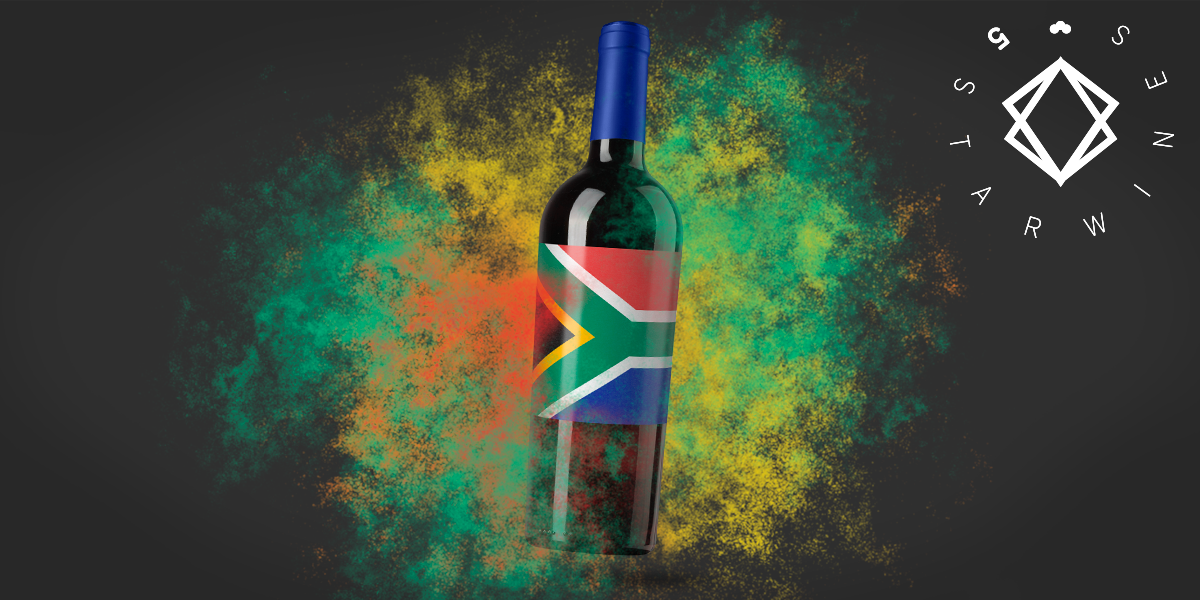
by Joy Livingston | Sep 18, 2019 | Blog Post
Importing Italian wine into South Africa (SA) might seem daunting since it is a prolific wine-producing nation in its own right. Breaking ground in this market takes effort, creativity and smart planning. To understand which wines would do well, and which are the demographics to target, one should first analyze the domestic market.
Domestic wine market situation in South Africa
SA’s domestic wine market situation is quite dynamic in general. SA grows a vast amount of grapes and makes interesting wines; moreover, it has a robust export industry. According to Forbes, the local wine grape acreage of approximately 235,000 acres (95,000 hectares) is more or less equivalent to 40% of the wine grape coverage in California.
SA’s vineyard is generally based on international trends and export demands. Statistics show how white grape varieties constitute 55.2% of the total acreage, with the popular Chenin Blanc representing the 18.6%. Red-wine varieties account for 44.8% of the national vineyard: Cabernet Sauvignon is the most popular red grape, making up 11.0% of the total. Shiraz comes in second with 10.3%, while Merlot accounts for 5.8%. Finally, the indigenous South African grape Pinotage (a cross between Pinot Noir and Cinsault) represents the 7.4%.
In terms of global wine production, SA ranks as 10th in overall volume production, accounting for 3.4% of the world’s wine (2018).
But what about Italian producers who are thinking about importing their wines into SA? How do international wines fare within the South African market?
Main issues for Italian wine import in South Africa
SA imports quite a bit of wine from Italy, according to a 2017 WESGRO report. France is the top import market, followed by Italy and Portugal. SA and Europe also enjoy a free trade agreement concerning organic products: since the organic wine industry is currently thriving in Italy, this is a category that producers can take advantage of.
The major issues concerning domestic wine production in SA are those derived from economic growth and spending. Consumers’ behavior concerns those who might be interested in importing wines into the country as well, since there has been a slight slowing-down of economic growth, with consumers spending less on wines over the past few years.
Another issue that might affect Italian importers would be the ever-increasing regulations on branding, as well as those on marketing restrictions on alcoholic products. SA’s legislation is currently quite strict on this matter, giving producers a hard time in distributing their name and limiting the ways they might go about selling their wines.
The advantages Italian wine importers might consider
The question that Italian importers would certainly ask is: how much demand is there for Italian wine in the SA market? The answer can be gleaned by looking at alcohol consumption statistics. Domestically, South Africans drink more beer and wine than the other alcoholic beverages (WHO), with beer (56%) representing the most popular choice (wine accounts “only” for 18%).
In terms of demographics, it seems that males consume more beer than females (34%, four times more than their conunterpart), and this percentage has remained quite consistent over the past 12 years. The prevalence of spirits being consumed amongst males is about twice that of females.
As for wine, the prevalence of consumption amongst males is only marginally higher than the one amongst females. This is the only sub-category where female prevalence is higher than males, and in this category females overtake males, specifically in the sparkling wine/champagne (8% vs. 7%) section. This tells us that there is a market for Italian sparkling wines such as Prosecco and Northern Italy Metodo Classico (Franciacorta, Trentodoc).
Italian wine grapes in South Africa
When it comes to Italian-style wines in SA, it seems that Italian grapes are quite popular. Even though Italian varieties make up a very small segment (under 1%) of South African vineyard, they are always in demand, since about 30 Cape cellars have at least one Italian variety in their portfolio. These data should be taken as a positive sign for Italian importers who want to appeal to the South African market: it seems that they would find a wide fan-base for this genre.
Taking these data into account, it would seem that there is a market for Italian wines in SA, and that some types such as Prosecco might be easier to sell to consumers. Perhaps it might take a little more effort in terms of marketing, but there is room to grow!
Want to read more articles just like this one?
Get our tips sent straight to your inbox: subscribe to 5StarWines’ newsletter!
[yikes-mailchimp form=”2″]
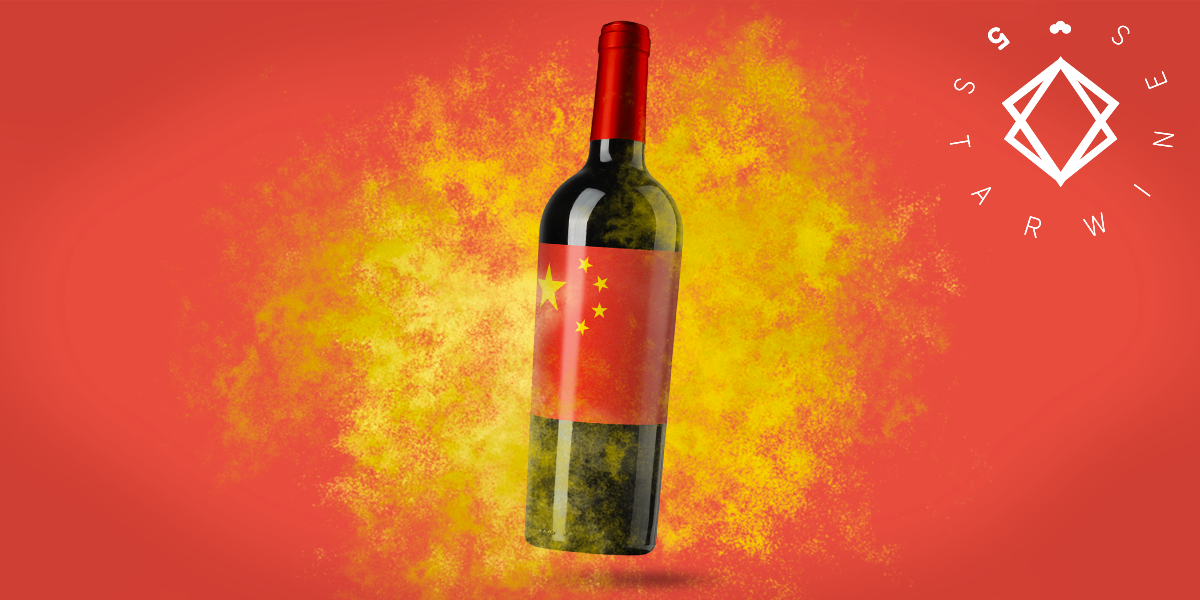
by Ornella Begalli | Jul 12, 2019 | Blog Post
Some of the cultural and ethical values deeply rooted in Chinese society are reflected in the way many of its companies operate. Understanding and knowing these principles is a great advantage for all those entrepreneurs who aim to gain a stronger and long-lasting foothold in the Chinese market. If you’re one of these individuals, our article is for you.
The Western approach to work has become part of the modus operandi in several Chinese companies. Even so, many of the business relationships established in this market are still based on millenary concepts of Confucian inspirations. There are three cultural values in particular that one should follow and learn about for those who really want to do business with China.
Guānxi(关系) or “friends first”
The concept of Guānxi is the result of China’s rural past, when every relationship was based on intense family connections and there was a strong sense of reciprocity. It is a value that arises exclusively from an authentic personal bond, which only later can lead to the work environment. You have Guānxi, only when two people become friends.
The first thing to do as a foreign company arriving in China is to reach a state of good Guānxi. How would one do this? Building networks, getting to know as many people as possible, building personal relationships. Only when the private bond becomes deep enough is it time to begin to trust the other party and work towards commercial goals. Guānxi helps us do business with someone we trust. Even signing a contract with someone with whom we don’t have a good Guānxi makes the power of the pact more limited. Why is that? Because in China some legal systems are not yet fully developed and relying on purely legal protection is not enough. It is much better to rely on a bond that goes beyond the working environment.
Miànzi(面子) or “kindness pays off, always”
The notion of Miànzi defines the reputation and dignity of an individual in social contexts. The concepts of honor, prestige and respect are exacerbated in many Eastern cultures, but it is in Chinese society that they play a fundamental role in any social interaction, especially in the business world. Miànzi promotes precisely these concepts. In Chinese working environments, showing respect for others is a fundamental practice to reach Miànzi; respecting to gain respect.
Have you planned a trip to Beijing for some of your employees? Then remind them to be considerate, listen and respond positively to the people they are going to interact with; showing a strong interest in others is rewarded. Always. On the contrary, warn them that indelicacy or being too direct in expressing opinions can have negative consequences (a characteristic approach that China shares with India, which we talked about in the article “4 things you should know about the Indian wine market“).
Rénqíng(人情) or “I help you, you help me”
This concept expresses both the demonstration of affection and attention, and the benefits and connections that one can derive from them. Simply put, Rénqíng is the way in which two people who know each other, help each other, and how this effort results in a common benefit: you help me this time, and next time I will return the favor. Clearly, this idea comes from the collectivist nature of Chinese society, where everyone is committed to contributing. The Rénqíng is also demonstrated by simple gestures, such as complimenting a friend or bringing a little present to a colleague. A seemingly small gesture, but it could take your company farther than the competition’s.
So next time you go to those new customers in China, don’t be surprised if a few dinners and a few good bottles are not enough to close the deal. You need someone who knows his Chinese counterpart’s business vision, who has built a strong Guānxi, who can show off a high Miànzi and who may already owe him a few favors. Actually, after reading this article the go-to person for the Chinese market could be you…
We want to be your company’s best advisor… Could you give us your mail?
[yikes-mailchimp form=”2″]

